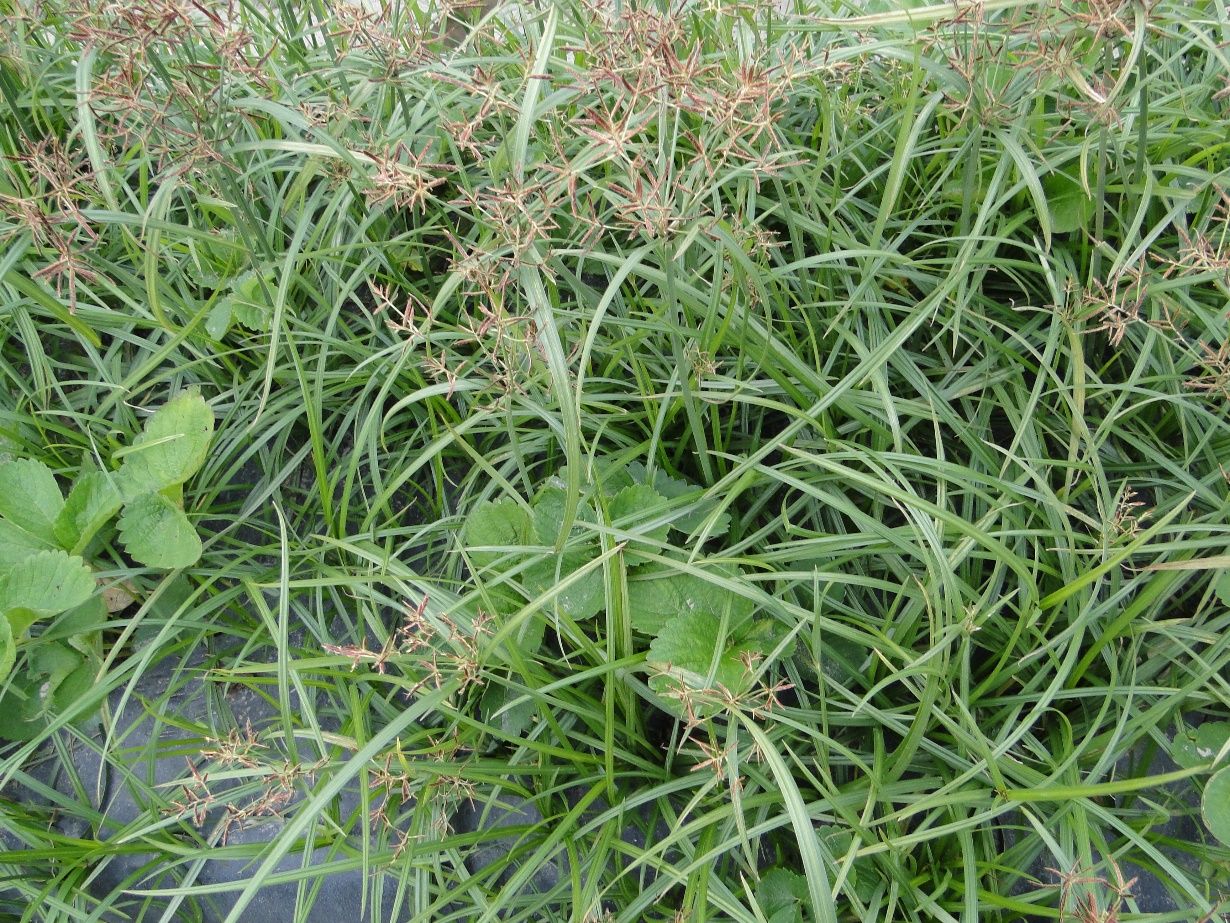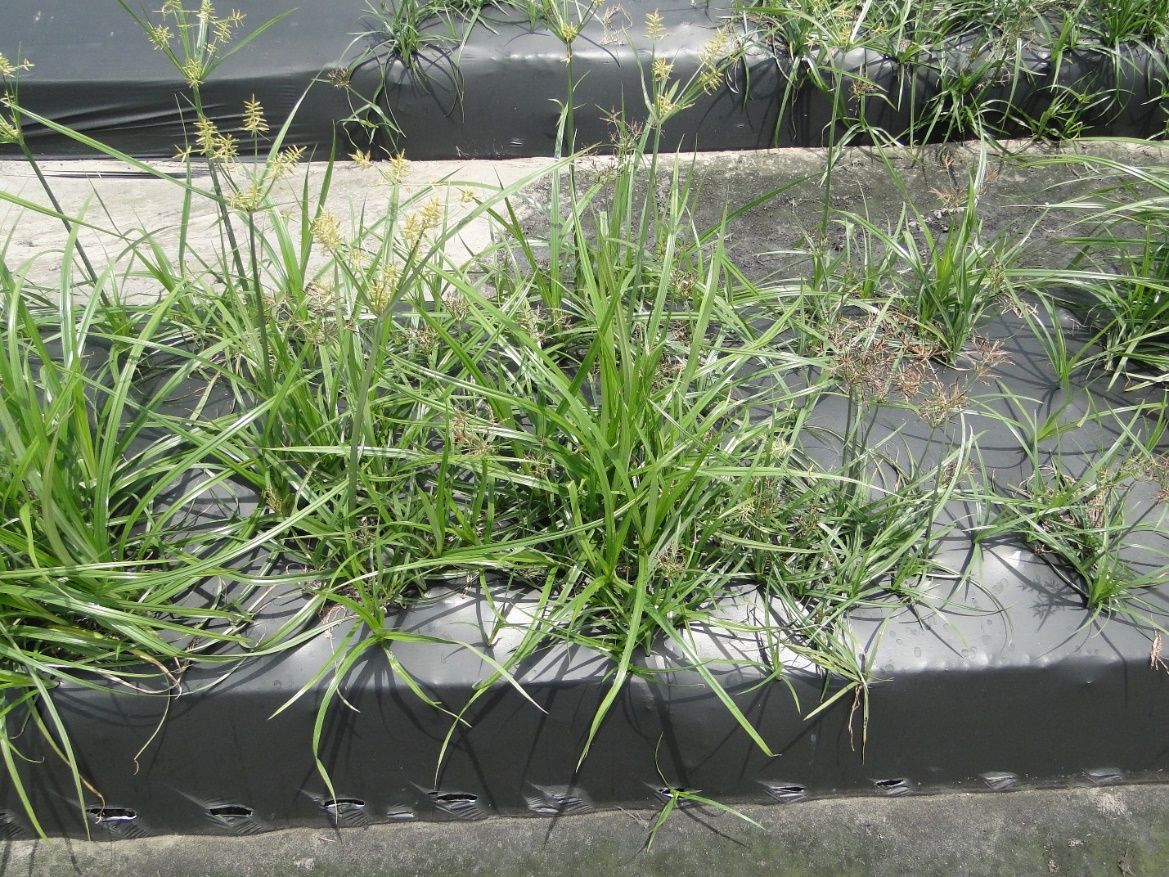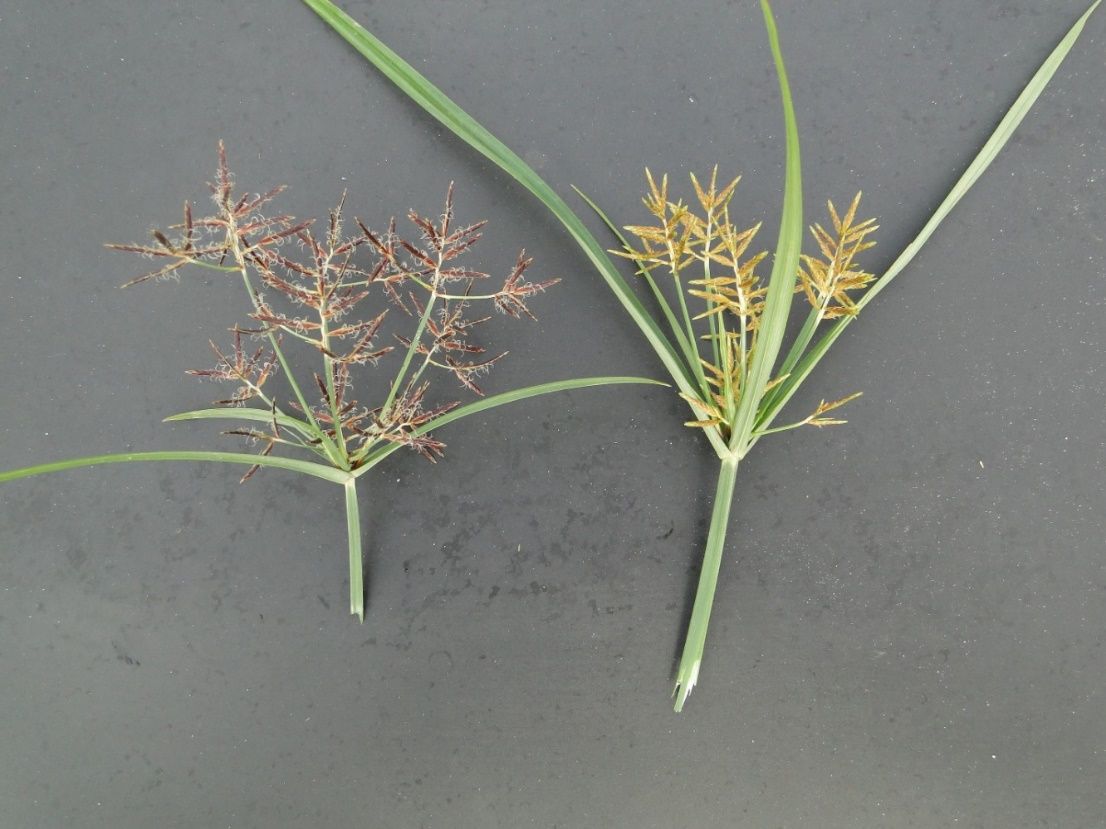Yellow and purple nutsedge are troublesome weeds in some Florida strawberry fields (Figure 1). They are the only two weed species with the capability to puncture plastic mulch used in the plasticulture production system (Figure 2). When not controlled, both species can reduce strawberry yields, reduce berry quality, reduce mulch integrity, and increase labor associated with mulch removal.

Credit: Nathan S Boyd, UF/IFAS

Credit: Nathan S Boyd, UF/IFAS
Purple and yellow nutsedge are perennial weeds that spread via underground roots called rhizomes and vegetatively produced structures known as tubers. Yellow nutsedge produces fewer but larger tubers located at the end of rhizomes whereas purple nutsedge produces more, smaller tubers in a chain along the rhizome. Purple nutsedge typically has darker green leaves with a blunt end whereas yellow nutsedge leaves tend to be lighter in color with a more tapered end. The seed head of purple nutsedge is red to purple in color whereas the seedhead of yellow nutsedge is tan to yellow (Figure 3). Purple nutsedge is generally more difficult to kill and less responsive to many types of herbicides than yellow nutsedge.

Credit: Nathan S Boyd, UF/IFAS
Nutsedge management is most successful in strawberry when multiple management tactics are integrated into an overall management program. Growers should focus on year-round control to prevent wide-scale establishment and spread of this weed. Due to the perennial nature of these species, nutsedge populations can quickly recover from previous management attempts if left uncontrolled for extended periods of time. Following is a list of potential management options.
Fumigation
It is important to use an effective fumigant system for areas of a field that have a history of nutsedge problems. Combinations of 1,3-dichloropropene and chloropicrin, which includes products such as Telone C-35 and Pic-Clor 60, are more effective than chloropicrin (ie. Tri-Pic 100) or 1,3-dichloropropene (Telone II) on their own. However, nutsedge control with any of these products tends to be inconsistent. Multi-year trials in Florida have found that the use of the Florida 3-Way system that consists of a premix of chloropicrin and 1,3-dichloropropene combined with KPam HL® or Vapam® enhances nutsedge control. KPam® or Vapam® can be applied with a minicoulter rig or injected through the drip tape to control nutsedge. It is difficult to achieve equal distribution of K-Pam or Vapam across the bed when injecting through the drip tape which results in the loss of control on the bed edges (Figure 4). Distribution can be improved by using a mini-coulter rig or installing 2 drip tapes in a bed. The use of TIF mulches will also improve fumigant efficacy compared with VIF or low barrier films.

Credit: Nathan S Boyd, UF/IFAS
Pre-Transplant
Nutsedge that emerges through plastic mulch prior to strawberry transplant can be controlled with glyphosate products (Roundup®, Touchdown etc). We recommend that a minimum of 1 inch of rain or overhead irrigation be applied prior to transplant to remove glyphosate residues from the plastic mulch. Preemergence (PRE) herbicides such as S-metolachlor (Dual Magnum) can be applied to row middles to suppress emergence. Emerged nutsedges in the row middles can be controlled with glyphosate applications.
In Crop
There are no registered PRE herbicides that can be applied under the plastic mulch for nutsedge control in strawberry. Some PRE herbicides registered for use in strawberry such as flumioxazin (ie. Chateau), napropamide (Devrinol DF-XT), and sulfentrazone (Spartan FL 4F) can suppress nutsedge but do not provide adequate control. All of the registered PRE herbicides are more effective on yellow than purple nutsedge. PRE herbicides such as sulfentrazone (Spartan® 4F) and S-metolachlor (Dual Magnum) can be applied to row middles to suppress emergence. Glyphosate can be applied to row middles to control emerged nutsedge. Burn-down products such as paraquat (Gramoxone SL) will burn off emerged shoots but the plant may recover. Hand weeding can be temporarily effective, but the plants will emerge again from the underground tubers.
Postharvest
At the end of the growing season, K-Pam HL or Vapam can be injected through the drip tape to terminate the crop and any weeds present. The use of a fumigant can also help reduce disease and nematode populations. Burn-down herbicides such as paraquat (Gramoxone SL) are commonly used to terminate the crop and will also desiccate above-ground parts of the plant but will not damage tubers. Applications of glyphosate products can be used to reduce the population of nutsedge tubers present in the soil.
Fallow Period
Poorly managed nutsedge populations during the fallow period will result in increased nutsedge pressure in the crop. Research conducted at the University of Florida found that the fallow management program was more important for long-term nutsedge control than fumigant selection. Cover crops are a recommended practice for fallow fields in Florida but although cover crops can suppress nutsedge growth they will not reduce the overall population size. Rotating cultivation with glyphosate applications is the most effective way to reduce tuber density in the soil. Cultivation will break the rhizomes that the tubers are attached to and maximize nutsedge emergence. The emerged nutsedge can then be controlled with glyphosate applications
Initial infestations of nutsedge will typically appear on field edges (Figure 2) and may obtain a foothold at the end of the rows where the fumigant has not been properly applied. It is important to maintain good weed management practices around the edges of the field. A little time spent at the early stages of infestation can help reduce the possibility of a nutsedge population increasing to the point where a full fumigant system will be required to keep the population below damaging levels.